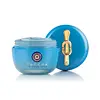What's inside
What's inside
 Key Ingredients
Key Ingredients

 Benefits
Benefits

 Concerns
Concerns

 Ingredients Side-by-side
Ingredients Side-by-side

Water
Skin ConditioningSqualane
EmollientDimethicone
EmollientPropanediol
SolventGlycerin
HumectantDiisostearyl Malate
EmollientOryza Sativa Bran Wax
Skin ConditioningBehenyl Alcohol
EmollientCamellia Sinensis Leaf
PerfumingIndigofera Tinctoria Leaf Extract
Skin ConditioningPolygonum Tinctorium Leaf/Stem Extract
Skin ConditioningAvena Sativa Kernel Extract
AbrasiveSophora Japonica Flower Extract
Skin ProtectingOryza Sativa Germ Oil
EmollientCocos Nucifera Oil
MaskingInositol
HumectantSericin
Skin ConditioningTetrasodium Tetracarboxymethyl Naringeninchalcone
Skin ConditioningAmorphophallus Konjac Root Powder
AbrasiveSodium Hyaluronate
HumectantSorbitan Tristearate
EmulsifyingTrihydroxystearin
Skin ConditioningDimethicone/Vinyl Dimethicone Crosspolymer
Skin ConditioningBeheneth-20
EmulsifyingBis-Diglyceryl Polyacyladipate-2
EmollientEthylhexylglycerin
Skin ConditioningButylene Glycol
HumectantSodium Dilauramidoglutamide Lysine
HumectantDisodium EDTA
Ethylhexyl Palmitate
EmollientSodium Acrylate/Acryloyldimethyltaurate/Dimethylacrylamide Crosspolymer
Emulsion StabilisingPhenoxyethanol
PreservativeCI 77891
Cosmetic ColorantMica
Cosmetic ColorantWater, Squalane, Dimethicone, Propanediol, Glycerin, Diisostearyl Malate, Oryza Sativa Bran Wax, Behenyl Alcohol, Camellia Sinensis Leaf, Indigofera Tinctoria Leaf Extract, Polygonum Tinctorium Leaf/Stem Extract, Avena Sativa Kernel Extract, Sophora Japonica Flower Extract, Oryza Sativa Germ Oil, Cocos Nucifera Oil, Inositol, Sericin, Tetrasodium Tetracarboxymethyl Naringeninchalcone, Amorphophallus Konjac Root Powder, Sodium Hyaluronate, Sorbitan Tristearate, Trihydroxystearin, Dimethicone/Vinyl Dimethicone Crosspolymer, Beheneth-20, Bis-Diglyceryl Polyacyladipate-2, Ethylhexylglycerin, Butylene Glycol, Sodium Dilauramidoglutamide Lysine, Disodium EDTA, Ethylhexyl Palmitate, Sodium Acrylate/Acryloyldimethyltaurate/Dimethylacrylamide Crosspolymer, Phenoxyethanol, CI 77891, Mica
Water
Skin ConditioningIsobutane
Propane
Perfluorohexane
SolventDimethicone
EmollientPropanediol
SolventIsosorbide Dicaprylate
Skin ConditioningTrimethylolpropane Tricaprylate/Tricaprate
EmollientEchinacea Purpurea Extract
MoisturisingPerfluorodecalin
Skin ConditioningPerfluoroperhydrophenanthrene
Skin ConditioningTropaeolum Majus Flower/Leaf/Stem Extract
Skin ConditioningZanthoxylum Bungeanum Fruit Extract
Skin ConditioningSodium Hyaluronate
HumectantHydrolyzed Hyaluronic Acid
HumectantSodium Polyglutamate
HumectantPolyglutamic Acid
Skin ConditioningAdenosine
Skin ConditioningChondrus Crispus Extract
Skin ConditioningGlycine Soja Seed Extract
Skin ConditioningHydrolyzed Vegetable Protein
Skin ConditioningTrehalose
HumectantOleyl Alcohol
EmollientGlycerin
Humectant1,2-Hexanediol
Skin ConditioningBetaine
HumectantPolysilicone-11
Lavandula Angustifolia Flower Oil
MaskingCetearyl Alcohol
EmollientGlyceryl Stearate
EmollientSodium Lauroyl Glutamate
Stearic Acid
CleansingAcrylates/C10-30 Alkyl Acrylate Crosspolymer
Emulsion StabilisingLaureth-12
EmulsifyingCaprylhydroxamic Acid
Sodium Benzoate
MaskingPotassium Sorbate
PreservativeGluconolactone
Skin ConditioningEthylhexylglycerin
Skin ConditioningSodium Hydroxide
BufferingPhenoxyethanol
PreservativeLinalool
PerfumingWater, Isobutane, Propane, Perfluorohexane, Dimethicone, Propanediol, Isosorbide Dicaprylate, Trimethylolpropane Tricaprylate/Tricaprate, Echinacea Purpurea Extract, Perfluorodecalin, Perfluoroperhydrophenanthrene, Tropaeolum Majus Flower/Leaf/Stem Extract, Zanthoxylum Bungeanum Fruit Extract, Sodium Hyaluronate, Hydrolyzed Hyaluronic Acid, Sodium Polyglutamate, Polyglutamic Acid, Adenosine, Chondrus Crispus Extract, Glycine Soja Seed Extract, Hydrolyzed Vegetable Protein, Trehalose, Oleyl Alcohol, Glycerin, 1,2-Hexanediol, Betaine, Polysilicone-11, Lavandula Angustifolia Flower Oil, Cetearyl Alcohol, Glyceryl Stearate, Sodium Lauroyl Glutamate, Stearic Acid, Acrylates/C10-30 Alkyl Acrylate Crosspolymer, Laureth-12, Caprylhydroxamic Acid, Sodium Benzoate, Potassium Sorbate, Gluconolactone, Ethylhexylglycerin, Sodium Hydroxide, Phenoxyethanol, Linalool
 Reviews
Reviews

Alternatives
Ingredients Explained
These ingredients are found in both products.
Ingredients higher up in an ingredient list are typically present in a larger amount.
Dimethicone is a type of synthetic silicone created from natural materials such as quartz.
What it does:
Dimethicone comes in different viscosities:
Depending on the viscosity, dimethicone has different properties.
Ingredients lists don't always show which type is used, so we recommend reaching out to the brand if you have questions about the viscosity.
This ingredient is unlikely to cause irritation because it does not get absorbed into skin. However, people with silicone allergies should be careful about using this ingredient.
Note: Dimethicone may contribute to pilling. This is because it is not oil or water soluble, so pilling may occur when layered with products. When mixed with heavy oils in a formula, the outcome is also quite greasy.
Learn more about DimethiconeEthylhexylglycerin (we can't pronounce this either) is commonly used as a preservative and skin softener. It is derived from glyceryl.
You might see Ethylhexylglycerin often paired with other preservatives such as phenoxyethanol. Ethylhexylglycerin has been found to increase the effectiveness of these other preservatives.
Glycerin is already naturally found in your skin. It helps moisturize and protect your skin.
A study from 2016 found glycerin to be more effective as a humectant than AHAs and hyaluronic acid.
As a humectant, it helps the skin stay hydrated by pulling moisture to your skin. The low molecular weight of glycerin allows it to pull moisture into the deeper layers of your skin.
Hydrated skin improves your skin barrier; Your skin barrier helps protect against irritants and bacteria.
Glycerin has also been found to have antimicrobial and antiviral properties. Due to these properties, glycerin is often used in wound and burn treatments.
In cosmetics, glycerin is usually derived from plants such as soybean or palm. However, it can also be sourced from animals, such as tallow or animal fat.
This ingredient is organic, colorless, odorless, and non-toxic.
Glycerin is the name for this ingredient in American English. British English uses Glycerol/Glycerine.
Learn more about GlycerinPhenoxyethanol is a preservative that has germicide, antimicrobial, and aromatic properties. Studies show that phenoxyethanol can prevent microbial growth. By itself, it has a scent that is similar to that of a rose.
It's often used in formulations along with Caprylyl Glycol to preserve the shelf life of products.
Propanediol is an all-star ingredient. It softens, hydrates, and smooths the skin.
It’s often used to:
Propanediol is not likely to cause sensitivity and considered safe to use. It is derived from corn or petroleum with a clear color and no scent.
Learn more about PropanediolSodium Hyaluronate is hyaluronic acid's salt form. It is commonly derived from the sodium salt of hyaluronic acid.
Like hyaluronic acid, it is great at holding water and acts as a humectant. This makes it a great skin hydrating ingredient.
Sodium Hyaluronate is naturally occurring in our bodies and is mostly found in eye fluid and joints.
These are some other common types of Hyaluronic Acid:
Learn more about Sodium HyaluronateWater. It's the most common cosmetic ingredient of all. You'll usually see it at the top of ingredient lists, meaning that it makes up the largest part of the product.
So why is it so popular? Water most often acts as a solvent - this means that it helps dissolve other ingredients into the formulation.
You'll also recognize water as that liquid we all need to stay alive. If you see this, drink a glass of water. Stay hydrated!
Learn more about Water